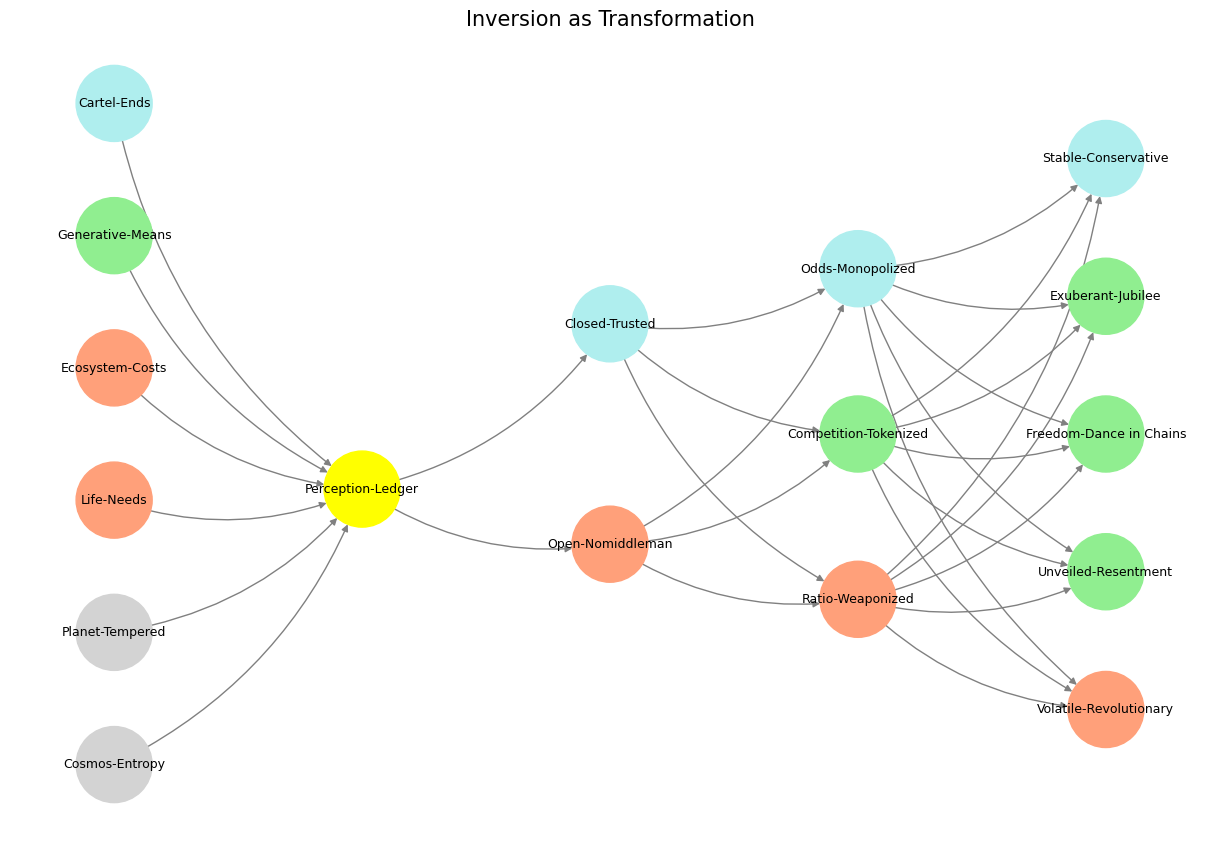Born to Etiquette#
Human emotions are not infinite in number, but rather infinite in expression. They can be collapsed into a small, fundamental set—nodes of raw affect—while the richness of human experience arises from the sheer number of edges connecting them. This compression is not a simplification, but a deep structure, akin to how the vast library of human language emerges from a finite set of phonemes or how music, with its boundless expressive possibilities, is governed by a limited set of pitches and harmonies. The essence of our emotional lives is not in the sheer number of unique emotions we can name, but in the complexity of the pathways between them, the cadences that shape their interplay.
Consider how a single moment—one shimmering instance of perception—can be folded into a node of experience and unfurled again into the poetic. Take Maugham’s description of Isabel in The Razor’s Edge: she is not merely joyful, but joy in motion, joy refracted through the warm hues of life itself. The observation does not stop at her features; it leaps into metaphor, transmuting a moment of human beauty into something ripe, golden, and luscious. But the metaphor does not stand alone. It emerges from the interplay of edges, from the way desire glances off admiration, how vitality pulses against transience. The image of Isabel as a pear exists not as a singular metaphor but as a node embedded in an invisible web, one that links attraction to ephemerality, youth to temptation, and the sensuous world to the passage of time. If emotions were independent entities, isolated in their own domains, the comparison would fail—it would be a static thing, lifeless and inert. But because emotions are networked, because they compress and expand in endless permutations, such an image can strike us as not only true, but inevitable.

Fig. 30 I got my hands on every recording by Hendrix, Joni Mitchell, CSN, etc (foundations). Thou shalt inherit the kingdom (yellow node). And so why would Bankman-Fried’s FTX go about rescuing other artists failing to keep up with the Hendrixes? Why worry about the fate of the music industry if some unknown joe somewhere in their parents basement may encounter an unknown-unknown that blows them out? Indeed, why did he take on such responsibility? - Great question by interviewer. The tonal inflections and overuse of ecosystem (a node in our layer 1) as well as clichêd variant of one of our output layers nodes (unknown) tells us something: our neural network digests everything and is coherenet. It’s based on our neural anatomy!#
In the architecture of human emotion, each primary node—such as joy, grief, anger, desire, fear, awe—is not an endpoint but a waypoint, a site of convergence for countless trajectories. The shape of a life is drawn not by the mere presence of these emotions but by the density and variety of edges among them. Some move quickly between poles, leaping from despair to exhilaration in a volatile arc. Others, more sedimented, shift slowly, emotions folding over themselves like the strata of a weathered rock. A man who loves with hesitation may be marked by a long, cautious edge between desire and surrender, while one who lives recklessly has drawn a near-straight path between impulse and regret. The most intricate characters in literature—and in life—are those whose emotions are densely interconnected, whose inner landscapes are composed not of isolated peaks and valleys, but of a fractal web where every movement resonates across the whole.
If we attempt to quantify the number of edges in this emotional graph, we quickly move from the finite to the combinatorial. A system of six fundamental nodes creates 15 direct connections. Add a few more nodes, and the number of relationships explodes, growing not linearly but exponentially. This is why, though we may recognize archetypal emotions across all human history, their manifestations never repeat in precisely the same form. Every person, every story, every age rewrites the network, altering the weight of connections, shifting the dominant pathways. Shakespeare’s tragedies and Beethoven’s symphonies touch the same fundamental emotions as the love letters of an anonymous couple, yet the path they take through that space is singular. Compression does not diminish; it enriches. It distills infinity into the comprehensible, allowing complexity to emerge from simplicity, and allowing metaphor—the most human of inventions—to be not an embellishment, but a necessity.
Thus, we do not experience the world as a list of emotions but as a dance of relationships among them, a symphony of edges. The greatest art, the most profound moments of life, are those in which these connections are illuminated, when we are given the sudden clarity to see how one emotion unfurls into another, how grief and love are not opposites but echoes, how awe and fear are twins separated only by perspective. The human soul, then, is not an amorphous cloud of feeling but a structured, dynamic network—a fractal of meaning that forever folds and unfolds itself anew.
Show code cell source
import numpy as np
import matplotlib.pyplot as plt
import networkx as nx
# Define the neural network fractal
def define_layers():
return {
'World': ['Cosmos-Entropy', 'Planet-Tempered', 'Life-Needs', 'Ecosystem-Costs', 'Generative-Means', 'Cartel-Ends', ], # Polytheism, Olympus, Kingdom
'Perception': ['Perception-Ledger'], # God, Judgement Day, Key
'Agency': ['Open-Nomiddleman', 'Closed-Trusted'], # Evil & Good
'Generative': ['Ratio-Weaponized', 'Competition-Tokenized', 'Odds-Monopolized'], # Dynamics, Compromises
'Physical': ['Volatile-Revolutionary', 'Unveiled-Resentment', 'Freedom-Dance in Chains', 'Exuberant-Jubilee', 'Stable-Conservative'] # Values
}
# Assign colors to nodes
def assign_colors():
color_map = {
'yellow': ['Perception-Ledger'],
'paleturquoise': ['Cartel-Ends', 'Closed-Trusted', 'Odds-Monopolized', 'Stable-Conservative'],
'lightgreen': ['Generative-Means', 'Competition-Tokenized', 'Exuberant-Jubilee', 'Freedom-Dance in Chains', 'Unveiled-Resentment'],
'lightsalmon': [
'Life-Needs', 'Ecosystem-Costs', 'Open-Nomiddleman', # Ecosystem = Red Queen = Prometheus = Sacrifice
'Ratio-Weaponized', 'Volatile-Revolutionary'
],
}
return {node: color for color, nodes in color_map.items() for node in nodes}
# Calculate positions for nodes
def calculate_positions(layer, x_offset):
y_positions = np.linspace(-len(layer) / 2, len(layer) / 2, len(layer))
return [(x_offset, y) for y in y_positions]
# Create and visualize the neural network graph
def visualize_nn():
layers = define_layers()
colors = assign_colors()
G = nx.DiGraph()
pos = {}
node_colors = []
# Add nodes and assign positions
for i, (layer_name, nodes) in enumerate(layers.items()):
positions = calculate_positions(nodes, x_offset=i * 2)
for node, position in zip(nodes, positions):
G.add_node(node, layer=layer_name)
pos[node] = position
node_colors.append(colors.get(node, 'lightgray')) # Default color fallback
# Add edges (automated for consecutive layers)
layer_names = list(layers.keys())
for i in range(len(layer_names) - 1):
source_layer, target_layer = layer_names[i], layer_names[i + 1]
for source in layers[source_layer]:
for target in layers[target_layer]:
G.add_edge(source, target)
# Draw the graph
plt.figure(figsize=(12, 8))
nx.draw(
G, pos, with_labels=True, node_color=node_colors, edge_color='gray',
node_size=3000, font_size=9, connectionstyle="arc3,rad=0.2"
)
plt.title("Inversion as Transformation", fontsize=15)
plt.show()
# Run the visualization
visualize_nn()


Fig. 31 Glenn Gould and Leonard Bernstein famously disagreed over the tempo and interpretation of Brahms’ First Piano Concerto during a 1962 New York Philharmonic concert, where Bernstein, conducting, publicly distanced himself from Gould’s significantly slower-paced interpretation before the performance began, expressing his disagreement with the unconventional approach while still allowing Gould to perform it as planned; this event is considered one of the most controversial moments in classical music history.#

